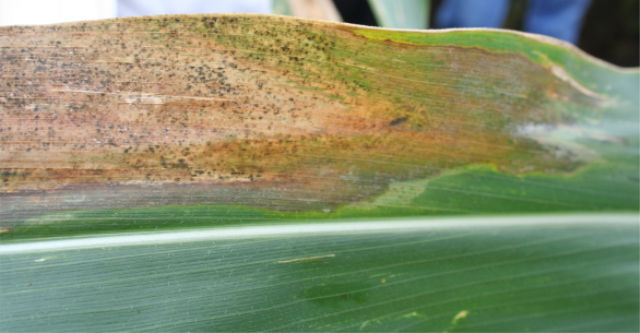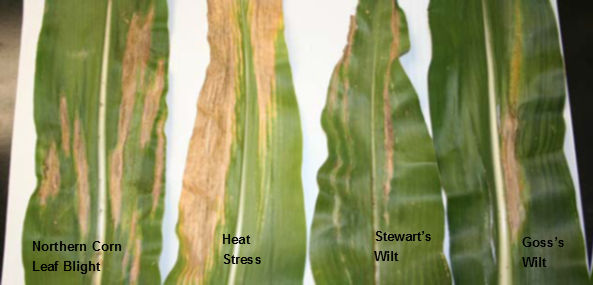3 MIN READ
Goss’s Wilt Identification and Management
September 5, 2018
KEY POINTS
- Goss’s Wilt is a bacterial disease that has increased in frequency and severity since first identified in Nebraska during 1969.
- Management practices to reduce incidences of bacteria-caused diseases include planting disease tolerant seed products, if available, and reducing pathogen inoculum in crop residue by tillage or crop rotation.
SYMPTOMS
Goss’s Wilt is an economically significant disease of dent corn, food-grade corn, sweetcorn, and popcorn.1 The disease occurs at one of two phases within the corn plant: seedling wilt that can result in a systemic infection, and an adult-plant wilt, which is typically associated with leaf blight. Although the seedling systemic wilt is observed less frequently than the leaf blight, early infection may result in wilted and dead seedlings.
The leaf blight phase causes gray to light yellow lesions with wavy margins that roughly follow leaf veins. Two characteristic symptoms of Goss’s Wilt are the presence of dark green to black water-soaked spots near the edges of expanding lesions or the appearance of “freckles” within infected areas of leaves (Figure 1). Goss’s Wilt “freckles” are luminous when leaves are held to block the sun (Figure 2). Bacterial exudates (ooze) on leaf surfaces can also be used to differentiate Goss’s Wilt as they have a shiny, shellac-like appearance when dried (Figure 3). Goss’s Wilt can be mistaken with symptoms of northern corn leaf blight, Stewart’s wilt, or necrotic areas of leaves resulting from drought or nutrient deficiencies (Figure 4, page 2).

Figure 1. Goss’s Wilt leaf freckles.

Figure 2. Goss’s Wilt leaf freckles appear luminous when held up to block the sun.

Figure 3. Goss’s Wilt bacterial ooze may have a shiny, shellac-like appearance.

Figure 4. Corn leaf symptoms, left to right - northern corn leaf blight, heat stress, Stewart’s wilt, and Goss’s Wilt.
DISEASE CYCLE
The pathogen that causes Goss’s Wilt overwinters in infested corn residue on the soil surface, which is the primary source of inoculum for the following corn crops. The pathogen enters plants through wounds created by wind, blowing soil (sandblasting effect), and hail. Additionally, the bacterium can enter plants through natural plant openings. The pathogen can survive in and on seed; however seed to seedling pathogen transmission is very low (about 2%).2 Insects have not been known to be a factor with the spread or development of Goss’s Wilt.1,2
The initial infection usually occurs as rain or irrigation water splashes the inoculum from infested corn residue onto corn plants. The optimal temperature for disease development is 80 °F and all plant parts can be infected.1
MANAGEMENT
Selecting seed products tolerant to Goss’s Wilt is the best management strategy to reduce the disease’s impact on yield potential. Other management practices that can contribute to reducing the amount of overwintering Goss’s Wilt inoculum include the following:
- Continuous corn rotations may increase the levels of overwintering Goss’s Wilt pathogen over time. Rotating to other non-host crops such as soybean, dry bean, small grains, or alfalfa will contribute to corn surface residue breakdown thus reducing the amount of overwintering inoculum for subsequent corn crops.
- Any tillage which buries infected crop residue, encouraging decomposition, can be effective in reducing the levels of the Goss’s Wilt pathogen. However, this may not be a viable option in all situations.
- Other hosts for the pathogen include foxtail species, shattercane, johnsongrass, large crabgrass, and a common cover crop annual ryegrass.3 Controlling these alternative plant hosts for Goss’s Wilt may contribute to reducing the amount of inoculum.
Sources:
1 Jackson, T.A., Harveson, R.M., and Vidaver, A.K. 2007. Goss’s bacterial wilt and leaf blight of corn. NebGuide, G1675. University of Nebraska –Lincoln. htttp://extensionpublications.unl.edu/
2 Wise, K., Ruhl, G., and Creswell, T. 2010. Goss’s bacterial wilt and leaf blight. BP-81-W. Purdue University Extension. https://www.extension.purdue.edu/
3 Freije, A., Ikley, J., Wise, K., and Johnson, B. 2015. Goss’s wilt on grass hosts. BP-88-W. Purdue University Extension. https://extension.purdue.edu/
4 Biddle, J.A., et. al. 1990. Seed transmission of Clavibacter michiganense subsp. Nebraskense in corn. Plant Disease 74:908-911. https://www.apsnet.org/
Web sources verified 07/17/18.
ID 180716122901